Comments on Judging the Miniature Schanuzer
(under construction, illustrations are still being added
from "Body" Section on)
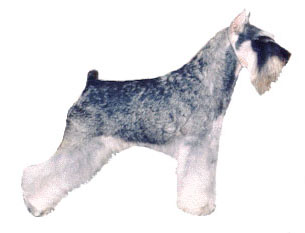 |
You will get more out of this presentation if you have a copy
of the AKC Standard for the Miniature Schnauzer to read along with it. You may get a
copy of it from the AKC website, as I do not
have permission from the American Miniature Schnauzer Club to reproduce it here.  The words in blue italics following
this symbol indicate the following paragraph refers to this heading in the standard.
This symbol will take you to the AKC website. The words in blue italics following
this symbol indicate the following paragraph refers to this heading in the standard.
This symbol will take you to the AKC website.
These comments are my own opinions from
30 years breeding, conditioning, handling, and in the last few years, judging this breed.
They do not represent any official position by the American Miniature Schnauzer
Club. |
| Because
there is a tendency to look at hair instead of structure, I chose to illustrate the body
of the dogs and use the hair only as a background. In a breed like this that has
expert groomers, a judge must use their hands to discover what's really underneath the
hair. I hope these comments serve as a means
to open discussion amongst judges and breeders. All diagrams are property of Chris Levy and may not be reproduced in any
way except by permission of the author. General  Appearance... Appearance...
General appearance: Robust, active,
terrier type, resembling the Standard Schnauzer. What does “terrier type”
mean? Does terrier type mean they should look like the all-American terrier outline (e.g.
Wire Fox Terrier) with the accompanying narrower body and short upper arm?
Or do they
look more like a small Standard Schnauzer (working dog with the accompanying movement).
Miniature Schnauzer breeders in the USA don’t agree among themselves on the
difference between “terrier type” and “schnauzer type”
and you will see both types in the show ring. 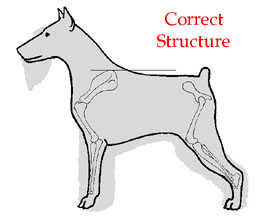
The American standard is the only one in the world that
mentions "terrier type", and indeed, North America is the only
place this breed is in the Terrier Group. The rest
of the world expects a small version of the Standard Schnauzer and places
them in either a Non-Sporting type group (e.g. Utility Group in the UK) or
the Schnauzer-Pinscher Group. European Miniature
Schnauzers are typically heavier bodied than their American counterparts, with hard coats,
fewer furnishings (which are all or in part, stripped), with tails expected to be carried
at 1 to 2 o'clock. For those really into comparisons, other countries'
standards are at www.schnauzerware.com.
Because the American standard is ambiguous in this
regard, some of the comparisons
between "schnauzer" and "terrier" type will be dealt with here. One
should note below, though, the many references in the American Standard to structure and
movement which are closer to a working dog than a terrier. The temperament is more
terrier-like than the Standard Schnauzer, but the Miniature has more of a calmer,
sensible, working dog attitude than what is thought of as "terrier temperament"..
|
 Size, Proportion, Substance.... Size, Proportion, Substance....Size:
The standard calls for both dogs and bitches to be between 12 and
14". To be 12" is OK, as it is OK to be 14", and above or below disqualify. Most dogs being shown today are
between 13-1/2 and 14 inches. Most breeders will only show a bitch less than 13” if
she is really exceptional, and almost no one will show a male under
13-1/2". The smaller
ones tend to look toyish when compared to the 14” ones, and toyishness is a
fault. Any Miniature Schnauzer over 12” should certainly be considered if it has all
the other schnauzer characteristics, including length and fill of muzzle, good bone and
body. Breeders have narrowed themselves into a very small range of size. A
14-1/4" dog can measure in if the owner knows how to stack the dog, but that is the
only leniency allowed in height. At least this breed doesn't have the problem as do
many breeds, of dogs 2” over the recommended height being top winners. Just a word of
caution - it is also possible to measure a 12-1/4” dog undersize because they have a
tendency to shrink down under the weight of the wicket. (I have personally noticed this in
measuring at home with a wicket.) There is no
mention in the standard of where the height measurement should take place. AKC rules say
it should be “at the highest point over a dog’s shoulder blades”. Many of
the dogs today have such poor layback of shoulder that it is conceivable that the highest
point over a dog’s shoulder blades could reach quite a ways up the neck.
That means that a dog with good shoulders can actually be an overall
larger dog and still measure the |
|
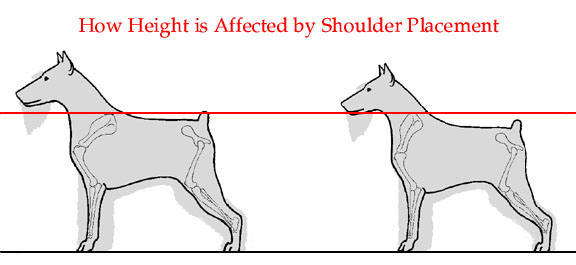
|
| The above dogs are the same
height, but because of the second dog's more vertical shoulder blades, it
must be overall a smaller dog in order to measure the same height. The dogs with very poor layback of shoulder
must also have much lower back height than those with good shoulders, since the well laid-back
shoulders are more at a level of the back. In
comparing two dogs of equal height, the one with better shoulder layback
will look bigger. Just remember, they are not measured at the back height.
If in doubt, measure. Never,
never, never, put a good dog to the back of the line because you think it may be oversize.
It makes the judge look foolish to the spectators, and you may have overlooked a good,
insize dog because of internal bone structure. Grooming and optical
illusions of body proportion can also fool your eye. A cobby, well-boned dog may appear larger than
one the same height, who is lankier and longer backed. Then again, if the lanky dog has
little chest, he may appear large because of the length of his legs (the air
under his body) in proportion to his body thickness. Color can also make a
difference in the appearance of size, as can the height of the dogs who happen to be
competing that day. Inevitably when an exhibitor decides to show a smaller
dog and all the others
competing are at the top of the standard, or conversely, shows a 14” dog and
all the others are much smaller. Don’t trust your eyesight. Experienced breeders and
judges may be able to tell on the exam table, but 1/4” accuracy is pretty hard to
guess correctly.
|
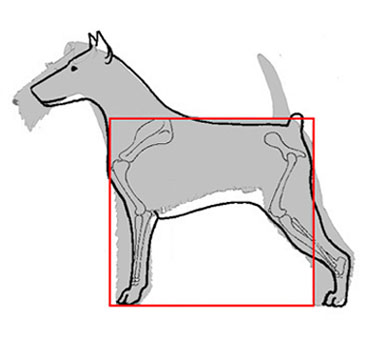 Proportion,
and comparison to the Wire Fox Terrier - the Miniature Schnauzer standard says
“nearly square”. The Wire Fox Terrier standard says the height at the withers
should equal the length of the body from shoulder point to buttock. The Miniature
Schnauzer standard says the overall length from the chest to the
buttocks appears to equal the height at the withers. Then should the Miniature Schnauzer
look the same proportions as the Fox Terrier? NO. The difference is in the size of the
body and basic structure. In the Fox Terrier the distance from ground to chest should
equal the distance from the chest to the withers. In the Miniature Schnauzer, even though
it is not specifically stated, the depth of the chest from the withers to the bottom of
the chest is greater than from the chest to the ground. Measuring the proportions of the
correct Miniature Schnauzer from the American Miniature Schnauzer Club Illustrated
Discussion, the chest would be 58% of the distance, or about 7/12. For a person
looking for that “all-American” (or 50:50 ratio) terrier, the correct Miniature
Schnauzer would look low on leg. Proportion,
and comparison to the Wire Fox Terrier - the Miniature Schnauzer standard says
“nearly square”. The Wire Fox Terrier standard says the height at the withers
should equal the length of the body from shoulder point to buttock. The Miniature
Schnauzer standard says the overall length from the chest to the
buttocks appears to equal the height at the withers. Then should the Miniature Schnauzer
look the same proportions as the Fox Terrier? NO. The difference is in the size of the
body and basic structure. In the Fox Terrier the distance from ground to chest should
equal the distance from the chest to the withers. In the Miniature Schnauzer, even though
it is not specifically stated, the depth of the chest from the withers to the bottom of
the chest is greater than from the chest to the ground. Measuring the proportions of the
correct Miniature Schnauzer from the American Miniature Schnauzer Club Illustrated
Discussion, the chest would be 58% of the distance, or about 7/12. For a person
looking for that “all-American” (or 50:50 ratio) terrier, the correct Miniature
Schnauzer would look low on leg. |
 Head:
Eyes and Ears Head:
Eyes and Ears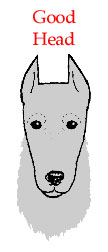 Eyes: Small,
dark brown, deepset, and oval. Very rarely will you see an eye that is too small,
the opposite is usually true. Interestingly enough, Miniature Schnauzers affected with
Congenital Cataracts will have a too-small eye. It is thought that is why the
problem became prevalent many years ago, because the breeders were attracted to the
smaller eye. Fortunately with test breeding, the problem is not frequent any more, and
test breedings are still being conducted to assure it doesn’t become a problem again.
Light and prominent eyes are very common and easy to hide under long
eyebrows. Be sure to check the eyes by tilting the dog’s head up to you, or by
lifting the eyebrow. Beards make great handles for maneuvering the head. Just take ahold
of the hair under the chin and tilt the head the way you want it. |
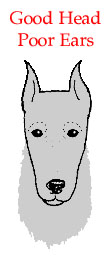
Ears, when cropped, are carried perpendicularly at the inner edges,
however cropping is man-made. The ear crop can be an asset or liability depending
on how well the crop was done, and to a lesser extent on the quality of the ear. Although
a poor ear crop takes away from the appearance of the Miniature Schnauzer, it should be
considered as an artificial liability and judged as such. Very few Miniature Schnauzers
have perpendicular edges on the inside of the ear, but it is most pleasing when you find
it, especially with as little bell (outside edge) as possible. Very few Schnauzers will hold their ears
up while on the examining table. It is best to see the ears when they’re on the
ground. |
| There is no preference for either cropped or
uncropped ears, however only a few uncropped Miniature Schnauzers have
finished their championships. The natural ear
gives a softer look to the Miniature Schnauzer, and because of that it may
be more
difficult to win with a natural-eared male than with a bitch. Many Miniature
Schnauzers, especially bitches, will not put their ears up for anyone, especially on the
table, and certainly not for strangers, so an uncropped ear can be a real liability if
they won’t use them in the ring. . |
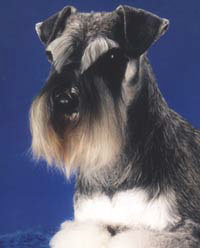
Good, uncropped ears
|
 Head:
Skull, Muzzle, & Teeth Head:
Skull, Muzzle, & Teeth
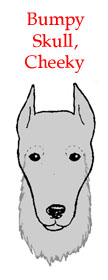 Head: Please
note, the standard says the muzzle should be at least as long as Head: Please
note, the standard says the muzzle should be at least as long as 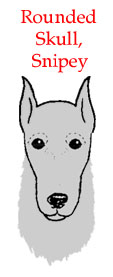 the
topskull. The
most frequent problem we see in heads is a shortened muzzle with little
fill, but the standard does not say, the longer the muzzle, the
better.
Grooming, especially bad grooming, can make a big difference in the look of the
head. Make sure to feel what the dog has under all that hair. You should not be able to
see the cheeks by looking at the head from the front. A dog may look cheeky, when in
fact the beard was trimmed too short on the sides of the face making the cheeks stand out.
Then again, it may really be cheeky. Getting your hands on the head of the dog is the best
way to find out. the
topskull. The
most frequent problem we see in heads is a shortened muzzle with little
fill, but the standard does not say, the longer the muzzle, the
better.
Grooming, especially bad grooming, can make a big difference in the look of the
head. Make sure to feel what the dog has under all that hair. You should not be able to
see the cheeks by looking at the head from the front. A dog may look cheeky, when in
fact the beard was trimmed too short on the sides of the face making the cheeks stand out.
Then again, it may really be cheeky. Getting your hands on the head of the dog is the best
way to find out.
There is very little problem with down faces, but rounded topskulls and
more than a slight stop are problems occasionally seen. Be sure to feel the stop as many
exhibitors leave excessive hair in that area.
Teeth are becoming a problem in the Miniature Schnauzer. They have a
lot of tartar problems with the resultant loss of teeth. There are also many scissors
bites so tight they barely qualify as scissors. The teeth should be large
and strong, not small. |

Neck, Topline, Body
Body: This is one place where the Miniature Schnauzer should
differ vastly from the Fox Terrier. The body of the Miniature Schnauzer is heavy compared
to the Fox Terrier, with well-sprung ribs, a well-filled loin, heavy haunches, and little
tuck-up in comparison. We are seeing more trouble with hips and haunches than we are with
ribs. Many Miniature Schnauzers, when looked at from above, seem to be
“pear-shaped” - too narrow in the loins and hips. When you pick up a Miniature
Schnauzer from the rear, you should know you really have a substantial (not fat) dog
there. There is also some tendency toward inadequate thigh muscles in conjunction with the
narrow hips. The size of the chest can make the Miniature Schnauzer seem too low on leg when compared to the Fox Terrier.
Tail: The tail should be carried between 12 o’clock and 1
o’clock. There is a big difference between tail set and tail carriage. It is very
easy to cover up a bad tailset if the tail is carried high by smoothing the hair over the
croup. It is better to have a tail that is well set, but carried lower, about 1
o’clock, than to have a low set tail which is carried high, because the cause of the
latter is poor structure, but the former is not. An easy way to tell tailset from a
distance is to look at the point of the buttocks or the rectum. When looking from the
side, a dog with a low tailset ( steep croup) will have the rectum and point of buttocks
much farther below the level of the topline than a dog with a good tailset. A squirrel
tail also is not correct, but should only be penalized the same as one carried too far the
opposite direction. Again, the tail set is more important.
 Forequarters &
Hindquarters
Forequarters &
Hindquarters
Structure: This part of the standard
describes a good, solid working dog structure. This description of the fore and hindquarters could
apply to any one of a number of sporting, working, or herding breeds. And this is perhaps
the area where the Miniature Schnauzer most needs to improve. It is nearly impossible to
find good layback of shoulders in this breed, and straight upper arms also a
problem.
In order to compensate for the straightness of shoulder, the dogs tend to have a dip in
the back which, when stacked with legs stretched out behind, make the dog appear to have a
longer neck and a shorter back.
Feet: A sweeps judge at Montgomery County remarked to me
several years ago that Miniature Schnauzers were losing their good quality feet. The
quality of the feet is not possible to assess visually because of the furnishings and
trimming, and they are rarely checked by judges in the ring. Flat feed do not
seem to be a problem as much as oval, rather than round, feet.
 Coat
Coat
Coat: There are many Miniature Schnauzers being shown
today with excellent quality coats, but you will see a number of them have soft and/or
thin coats. This aspect of the dog is as important as any of the others, but it seems to
be overlooked quite often. There does seem to be differences in coat quality between the
colors, with the salt and peppers having the best, the blacks next, and the black and
silvers the worst. The coat tends to feel softer as it gets longer, since the individual
hairs get thinner in diameter as they grow out.
Most Miniature Schnauzers are stripped several times a year by either pulling
out the hard outer coat and leaving the undercoat, or by stripping all the hair out
leaving nothing but skin. The stripping is “staged”, so that the body hair will
be longer than the shoulder, neck, and head hair. Once the stripping has been started, it
is 9 to 11 weeks before the dog can be shown, and then only until the coat is 16 to 18
weeks along, then the stripping process must begin again. During the time the dog is in
coat, the exhibitor must go to as many shows as possible in that 7-9 week interval. I feel
this may account for some of the extreme competition you see in the Miniature Schnauzer
ring - it’s actually desperation. With many breeds its “oh well, there are more
shows next week”, whereas the Miniature Schnauzer exhibitor feels desperation when
they didn’t win this week “I only have 4 more weekends to get his points!”
before they’re out of commission for another two months. Because of this, exhibitors
attempt to get as much out of a coat as they can, and it is not unusual to see Miniature
Schnauzers exhibited “in their underwear” with maybe 1/4” of hair, or on
the opposite, a blown coat worked to the extreme to get another week out of it. The
standard only says the coat should be of sufficient length to determine texture, so some
forgiveness may be in order on the part of the judge in the coat length. We’ve heard
judges say “I like my Miniature Schnauzers to be in a longer coat” or a
“shorter coat”. Is it fair to expect an exhibitor to strip their dog so that it
can be in coat for what one judge happens to prefer?
More and more dogs are being seen in a rolled coat, where portions of the
hair are stripped out constantly and new coat is always coming in. Some exhibitors are
very good at this and some are not. It is very difficult to roll a Miniature
Schnauzer’s coat because of the quality of the coat (or lack thereof), including the
thickness/thinness of the coat, but also because of the amount of undercoat the dogs have.
It is very easy for the undercoat to completely dominate the hard coat if not raked out
constantly. Rolling the coat also lightens the appearance of the coat color in salt and
peppers because of the banding of the hairs, when the white part of the hair shows
through. They also don’t have the shiny look of a dog stripped out all at once.
 Color
Color
Coat Color: The colors are frequently interbred, and in fact
the blacks and black & silvers of today owe their quality to an infusion of salt and
pepper stock. The black color is dominant to salt and pepper which is dominant to black
and silver. This makes getting a quality black and silver very difficult. The colors are
polygenetic, though and a black can carry all three genes. It should be
noted that in some countries in Europe the colors are not allowed to be interbred.
 Color: Salt & Pepper
Color: Salt & Pepper
The banded hair is black on the tip, white below, and then gray. The
length of the banding colors varies between dogs. The dark salt and peppers tend to have a
longer band of black on the hair than the lighter colored dogs, and they could also have a
larger percentage of solid black hairs. The hair also gets thinner and finer as it gets
longer. This explains why, when a Miniature Schnauzer is clippered for a time, he will end
up with a soft, solid gray coat - you have cut off the hard, banded portion of the hair.
 Color: Black &
Silver
Color: Black &
Silver
The black and silver is a black and white dog with the same color pattern
as the salt and pepper, which is a gray and white dog. The well-colored black and silvers
have black going quite a ways down into the leg furnishings. Probably the most significant
problem with the black and silvers is the color of the scissored portions of the coat -
furnishings and chest. This is due to lack of good color of the undercoat. If the
undercoat is black, the chest will be black. Since the recent addition of the black chest
requirement to the standard, many exhibitors are coloring the chest black. This is usually
very easy to spot, because they color the sides of the chest black, but not the front (the
chest hair between the front legs) of the chest. If you look at a dog from the front and
his chest is all white, and from the side it is black, the dog has been colored. Even on a
dog with good color, there is a tendency to fade a little on the stripped portion of the
head (topskull). Black and silvers also tend to have some brown hairs at the top of the
hock joint in the stripped portion. This is normal and not to be penalized.
Because of the extensive black coloring of the legs on a black and silver,
it is sometimes very difficult to tell if the dog is moving correctly, especially in the
rear. The coloring varies by dog, but in some it may make them look cow-hocked, others
open-hocked, or other faults as the two colors of hair move around while the dog is in
motion. This must be taken into account when judging this color and not confused with an
actual fault.
 Color: Black
Color: Black
Unfortunately, the majority of black Miniature Schnauzers being shown
today are dyed black (usually just the furnishings). In breeding to salt and peppers to
improve the quality of the dog, the intensity of the coat color was lost. The furnishings
of an undyed dog will be slightly brown or gray tinged, as opposed to the stripped portion
of the dog which should be a jet black color. Fortunately, many black breeders are trying
very hard to get the good coat color back, and we are seeing more and more undyed dogs in
the ring. I would not penalize a dog with slightly discolored black furnishings - it
means the dog has good enough color it didn't need to be dyed.
Because the black color absorbs light, I believe it is easier to make a
black dog look good than either of the other two colors. If a groomer can trim a black
schnauzer to present a good outline, that is what the judge will see because the other
contours of the dog are absorbed and disappear. It is also true that a bad groomer can
easily make a good black dog look bad if they’re not careful about grooming for
outline. It is also difficult to see black Schnauzers in a poorly lit show area, or
against dark colored curtains or an exhibitor’s dark colored pants or skirt.
 Color Disqualification
Color Disqualification
There are white Miniature Schnauzers being bred, and there is occasionally
a parti-color, both of which are disqualifications. Many puppies are born with small white
blazes, which shrink in size as the puppy matures, and this is acceptable. What is not
acceptable is a blaze that extends from the white “butterfly” to the white on
the throat. This portion was added at the last standard revision because the parent club
felt that it was beginning to be a problem in the breed.
 Gait
Gait
What we see frequently are sickle hocks and lack of drive in the rear.
Just because a dog is moved fast, does not mean that the dog moves with reach and drive -
he may just “shuffle quickly”. The rear should look like pistons going away from
you.
Many exhibitors tend to leave more hair on the top of the rear pastern
(hock) than at the bottom to give the dog more rear angulation when standing. What
that does when the dog moves is to make it look like the dog is sickle hocked. It is
important to try to see where the leg bones are when a dog is moving from the side, not
just where the hair is. It help to check the length of hair at the back of the hock
when the dog is on the table.
 Temperament
Temperament
Miniature Schnauzers are absolutely devoted to whoever feeds and loves
them - in that way they are very fickle, but it makes it easy to place older dogs. They
are very sensitive and friendly. They will bark if the doorbell rings, but most will greet
strangers as though they were a long lost friend. They are not fighters, but usually will
not back down if threatened. The males usually will spar in the ring, but the majority of
bitches will show no interest. The dogs always look best when sparred and it is an easy
way to see what the dogs really look like without the handler’s interference. But
trying to spar bitches may be a disappointment, because every one of them may look up
lovingly at their handler and refuse to look at each other.
A comparison of the Miniature Schnauzer and Wire Fox
Terrier:
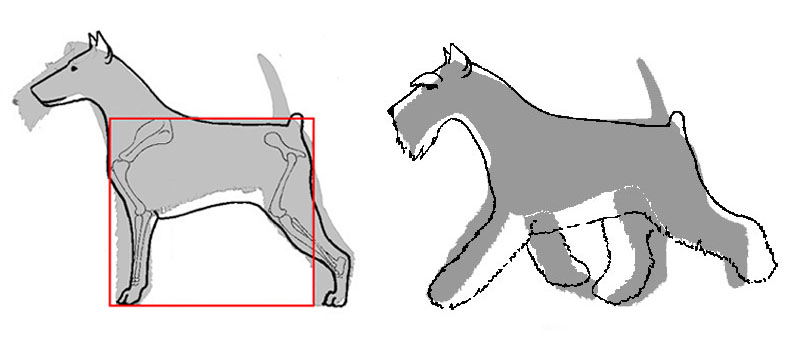
The outline shapes taken were from official documents of the respective parent clubs.
The Wire Fox Terrier is a larger dog, but the images have been changed in size so that the
height at the withers (and therefore the length of body) is the same.
Please notice the differences in the
- proportions of the head (depth vs. length)
- topline
- depth of the chest
- reach and drive
I hope this information has been of help to you. Please feel free to email me with comments.
My interpretation is always open to academic discussion and I welcome that. It
is important that Miniature Schnauzer breeder/exhibitors feel free to openly discuss their
breed and their interpretation of the standard without judgment on anyone's part.
This is the way we each learn and by each of us learning it makes us better breeders,
exhibitors, and judges.
Chris Levy, 1999
| Last updated March 24, 2003 |
Created by: Chris Levy |
Copyright ©1997 Abiqua Miniature Schnauzers
All Rights Reserved
|
|

 The words in blue italics following
this symbol indicate the following paragraph refers to this heading in the standard.
This symbol will take you to the AKC website.
The words in blue italics following
this symbol indicate the following paragraph refers to this heading in the standard.
This symbol will take you to the AKC website.

 Proportion,
and comparison to the Wire Fox Terrier - the Miniature Schnauzer standard says
“nearly square”. The Wire Fox Terrier standard says the height at the withers
should equal the length of the body from shoulder point to buttock. The Miniature
Schnauzer standard says the overall length from the chest to the
buttocks appears to equal the height at the withers. Then should the Miniature Schnauzer
look the same proportions as the Fox Terrier? NO. The difference is in the size of the
body and basic structure. In the Fox Terrier the distance from ground to chest should
equal the distance from the chest to the withers. In the Miniature Schnauzer, even though
it is not specifically stated, the depth of the chest from the withers to the bottom of
the chest is greater than from the chest to the ground. Measuring the proportions of the
correct Miniature Schnauzer from the American Miniature Schnauzer Club Illustrated
Discussion, the chest would be 58% of the distance, or about 7/12. For a person
looking for that “all-American” (or 50:50 ratio) terrier, the correct Miniature
Schnauzer would look low on leg.
Proportion,
and comparison to the Wire Fox Terrier - the Miniature Schnauzer standard says
“nearly square”. The Wire Fox Terrier standard says the height at the withers
should equal the length of the body from shoulder point to buttock. The Miniature
Schnauzer standard says the overall length from the chest to the
buttocks appears to equal the height at the withers. Then should the Miniature Schnauzer
look the same proportions as the Fox Terrier? NO. The difference is in the size of the
body and basic structure. In the Fox Terrier the distance from ground to chest should
equal the distance from the chest to the withers. In the Miniature Schnauzer, even though
it is not specifically stated, the depth of the chest from the withers to the bottom of
the chest is greater than from the chest to the ground. Measuring the proportions of the
correct Miniature Schnauzer from the American Miniature Schnauzer Club Illustrated
Discussion, the chest would be 58% of the distance, or about 7/12. For a person
looking for that “all-American” (or 50:50 ratio) terrier, the correct Miniature
Schnauzer would look low on leg.


 Head: Please
note, the standard says the muzzle should be at least as long as
Head: Please
note, the standard says the muzzle should be at least as long as  the
topskull. The
most frequent problem we see in heads is a shortened muzzle with little
fill, but the standard does not say, the longer the muzzle, the
better.
Grooming, especially bad grooming, can make a big difference in the look of the
head. Make sure to feel what the dog has under all that hair. You should not be able to
see the cheeks by looking at the head from the front. A dog may look cheeky, when in
fact the beard was trimmed too short on the sides of the face making the cheeks stand out.
Then again, it may really be cheeky. Getting your hands on the head of the dog is the best
way to find out.
the
topskull. The
most frequent problem we see in heads is a shortened muzzle with little
fill, but the standard does not say, the longer the muzzle, the
better.
Grooming, especially bad grooming, can make a big difference in the look of the
head. Make sure to feel what the dog has under all that hair. You should not be able to
see the cheeks by looking at the head from the front. A dog may look cheeky, when in
fact the beard was trimmed too short on the sides of the face making the cheeks stand out.
Then again, it may really be cheeky. Getting your hands on the head of the dog is the best
way to find out. 